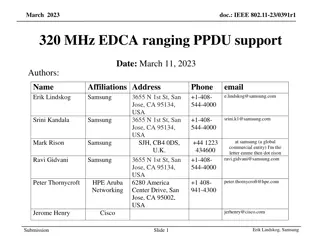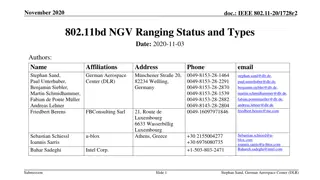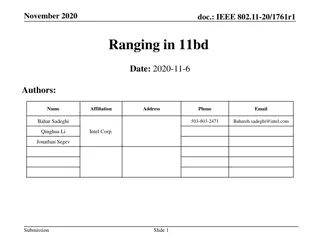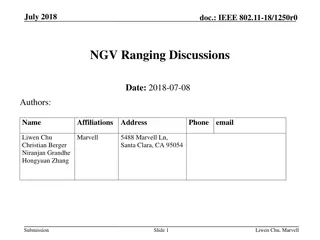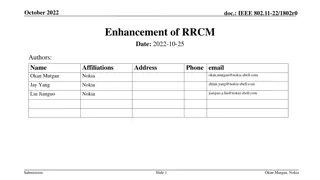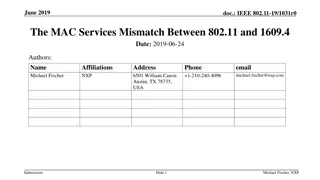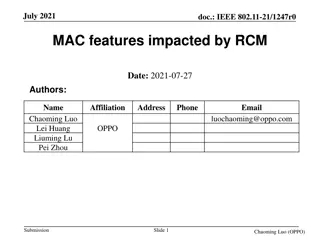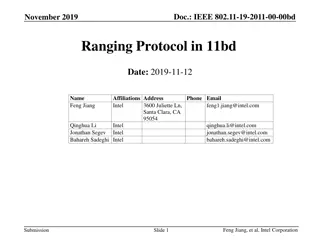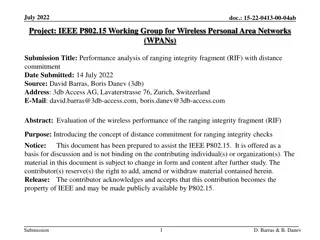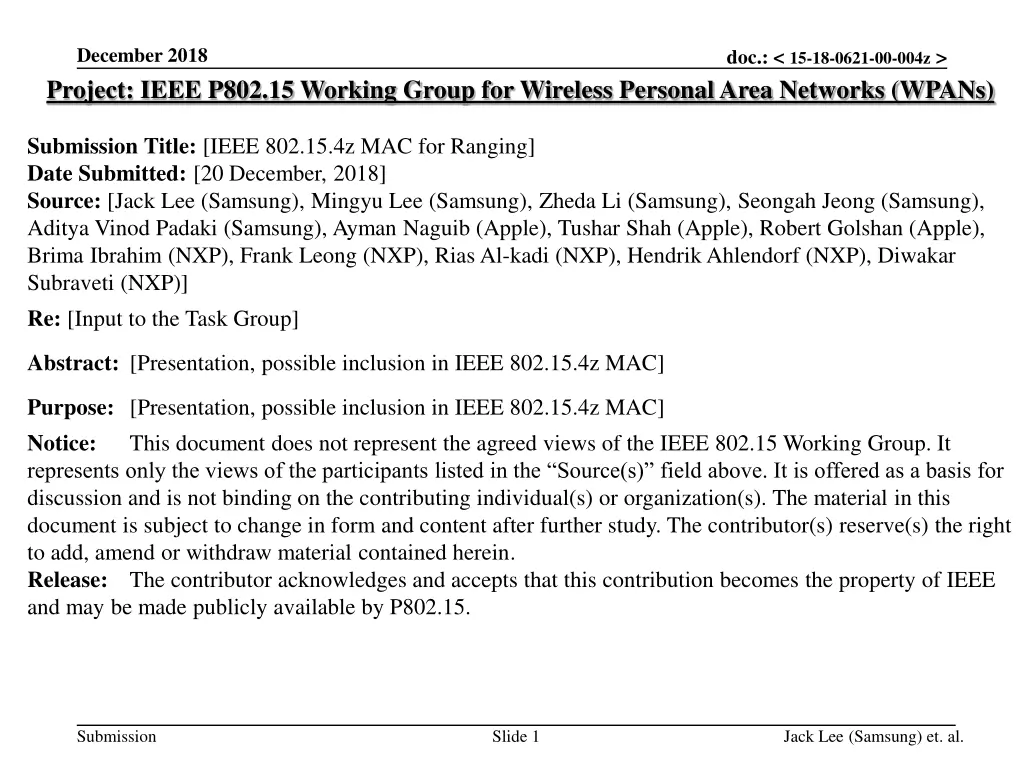
IEEE 802.15.4z MAC for Ranging in Wireless Networks
Explore the technical details of IEEE 802.15.4z MAC designed for ranging in wireless personal area networks (WPANs). The document provides insights into ranging methods, round structures, and use cases for SS-TWR and DS-TWR configurations. Learn about the general descriptions, ranging message sequences, and numerology included in the submission.
Download Presentation

Please find below an Image/Link to download the presentation.
The content on the website is provided AS IS for your information and personal use only. It may not be sold, licensed, or shared on other websites without obtaining consent from the author. If you encounter any issues during the download, it is possible that the publisher has removed the file from their server.
You are allowed to download the files provided on this website for personal or commercial use, subject to the condition that they are used lawfully. All files are the property of their respective owners.
The content on the website is provided AS IS for your information and personal use only. It may not be sold, licensed, or shared on other websites without obtaining consent from the author.
E N D
Presentation Transcript
December 2018 Project: IEEE P802.15 Working Group for Wireless Personal Area Networks (WPANs) doc.: < 15-18-0621-00-004z > Submission Title: [IEEE 802.15.4z MAC for Ranging] Date Submitted: [20 December, 2018] Source: [Jack Lee (Samsung), Mingyu Lee (Samsung), Zheda Li (Samsung), Seongah Jeong (Samsung), Aditya Vinod Padaki (Samsung), Ayman Naguib (Apple), Tushar Shah (Apple), Robert Golshan (Apple), Brima Ibrahim (NXP), Frank Leong (NXP), Rias Al-kadi (NXP), Hendrik Ahlendorf (NXP), Diwakar Subraveti (NXP)] Re: [Input to the Task Group] Abstract: [Presentation, possible inclusion in IEEE 802.15.4z MAC] Purpose: [Presentation, possible inclusion in IEEE 802.15.4z MAC] Notice: This document does not represent the agreed views of the IEEE 802.15 Working Group. It represents only the views of the participants listed in the Source(s) field above. It is offered as a basis for discussion and is not binding on the contributing individual(s) or organization(s). The material in this document is subject to change in form and content after further study. The contributor(s) reserve(s) the right to add, amend or withdraw material contained herein. Release: The contributor acknowledges and accepts that this contribution becomes the property of IEEE and may be made publicly available by P802.15. Submission Slide 1 Jack Lee (Samsung) et. al.
December 2018 doc.: < 15-18-0621-00-004z > Contents 1. General Descriptions for Ranging 2. Ranging IEs for Configuration 3. Ranging IEs for SS-TWR/DS-TWR 4. Examples of Ranging Message Sequences 5. Use Cases of SS-TWR 6. Use Cases of DS-TWR Submission Slide 2 Jack Lee (Samsung) et. al.
December 2018 doc.: < 15-18-0621-00-004z > General Descriptions for Ranging Submission Slide 3 Jack Lee (Samsung) et. al.
December 2018 doc.: < 15-18-0621-00-004z > Ranging Methods Ranging Methods of IEEE 802.15.8 are reused SS-TWR DS-TWR (w/ three messages) Submission Slide 4 Jack Lee (Samsung) et. al.
December 2018 doc.: < 15-18-0621-00-004z > Ranging Round & Ranging Block Ranging Round Ranging Round refers to the completion of the entire ranging event between the initiator(s) and the responder(s) of the UWB network Ranging Round consists of multiple Ranging Slots Ranging Block Ranging Block refers to a time frame for secure ranging Ranging Block consists of multiple Ranging Rounds Ranging Block Ranging Round 1 Ranging Round 2 Ranging Round 3 Ranging Round 4 Ranging Round N Ranging Slot 1 Ranging Slot 2 Ranging Slot 3 Ranging Slot M Submission Slide 5 Jack Lee (Samsung) et. al.
December 2018 doc.: < 15-18-0621-00-004z > Numerology TU is defined as the minimum MAC time step in PHY units Slot is defined as integer number of TUs Round is defined as integer number of Slots Block length is defined as integer multiple of MinimumBlockLength MinimumBlockLength is defined as an integer number of TUs Submission Slide 6 Jack Lee (Samsung) et. al.
December 2018 doc.: < 15-18-0621-00-004z > Ranging Round Ranging Round consists of one or more polling periods (PP) and one or more ranging response periods (RRP) PP is the period used by the initiator(s) to communicate to the responder(s) RRP is the period used by responder(s) to communicate to the initiator(s) <SS-TWR> Ranging Control Frame : Sent by controller RCF RCF P1 R1 R2 R3 RN RRP PP Polling message m: Sent by initiator m Pm <DS-TWR> Response from device n: Sent by responder n Rn RCF P1 R1 R2 R3 RN P 1 RRP PP PP Reply final poll message m: Sent by Initiator m P m <Many-to-Many (M2M) DS-TWR> P2 P3 R1 R2 R3 RN RCF P1 P 2 P 3 PM P 1 P M PP PP RRP Submission Slide 7 Jack Lee (Samsung) et. al.
December 2018 doc.: < 15-18-0621-00-004z > Ranging Configuration (1/2) Ranging Control Frame is to set Ranging parameters Ranging Control Frame shall be sent at the beginning of the active Ranging Round(s) Two device types for ranging control Ranging Controller - The device that defines and controls the ranging parameters by sending a Ranging Control Frame Ranging Controlee - The device that utilizes the ranging parameters received from the ranging controller. - There can be one or more controlees managed by the controller. Controlee Controller Ranging Control Frame Submission Jack Lee (Samsung) et. al. Slide 8
December 2018 doc.: < 15-18-0621-00-004z > Ranging Configuration (2/2) Two device types for ranging Initiator - Device initiates ranging by sending a Poll Responder - Device responds to Poll received from Initiator Controlee Controller Controlee Controller Ranging Control Frame Ranging Control Frame Initiator Responder Responder Initiator Poll Poll Submission Slide 9 Jack Lee (Samsung) et. al.
December 2018 doc.: < 15-18-0621-00-004z > Ranging Modes : Interval based Mode Ranging block length is multiple of MinimumBlockLength, and can be adjusted There can be multiple active ranging rounds within a ranging block. Ranging Interval is multiple of MinimumBlockLength plus multiple of length of slot Interval based Mode Ranging Interval Multiple of MinimumBlockLength Multiple of length of slot Ranging Block Ranging Block Ranging Round M Ranging Round 1 Ranging Round 1 Ranging Round N * Ranging Block = Multiple of MinimumBlockLength Submission Slide 10 Jack Lee (Samsung) et. al.
<month year> doc.: < 15-18-0621-00-004z > Ranging Modes : Block based Mode Ranging block length is multiple of MinimumBlockLength, and can be adjusted Time schedule for next active ranging round is repeatedly transmitted block-by-block: block, round, and slot index for the next active ranging round to start Referring to the selected ranging block and the selected ranging round, the active ranging round of a block starts with a randomly selected slot offset Inactive Active Block based Mode Multiple of Ranging block length Ranging Block N Ranging Block 1 Ranging Block 2 Ranging Round Ranging Block = Multiple of MinimumBlockLength Ranging Round round slot offset Scheduled time for next active ranging round Submission Slide 11 Jack Lee (Samsung) et. al.
December 2018 doc.: < 15-18-0621-00-004z > Ranging IEs for Configuration Submission Slide 12 Jack Lee (Samsung) et. al.
December 2018 doc.: < 15-18-0621-00-004z > Ranging IEs for Configuration IE Name Acronym RC IE Ranging Control IE RIU IE Ranging Interval Update IE RRS IE Ranging Round Start IE RNRR IE Next Ranging Round IE RFU IE Ranging Block Update IE RS IE Ranging Scheduling IE RNCP IE Ranging Next Channel and Preamble IE RMR IE Ranging Max Retransmission IE RSI IE Ranging STS Index IE Submission Slide 13 Jack Lee (Samsung) et. al.
December 2018 doc.: < 15-18-0621-00-004z > Ranging Control IE Parameters Value Description Size 0: Controller 1: Controlee 00: Normal 01: Secure w/o Payload 10: Secure w Payload 11: Reserved 00: Unicast 01: Multicast 10: Broadcast 11: Many-2-Many 0: Contention 1: Scheduled Indicates whether the device to send the poll is a Controller (0) or a Controlee (1) Indicates whether the ranging frame has no STS with payload (0), STS without Payload(1), STS with Payload(2) Poll Mode 1 bit Secure Mode 2 bits Indicates whether the transmission is Unicast (00), Multicast (01), Broadcast (10), or Many-to-Many (11). Cast Mode 2 bits Indicates whether the ranging is contention based (0) or scheduled (1). Applies when Cast Mode is 01 or 11. Multicast Mode 1 bit 0: SS-TWR 1: DS-TWR 0: Invoking Interval Update IE 1: Invoking Interval Update IE and Block Structure IEs # of TU Indicates if the ranging is SS-TWR (0) i.e., no final reply poll; or DS- TWR (1) i.e., includes a final reply poll. Indicates if the Interval IE is invoked (0) i.e., Interval based mode; or Interval Update IE and Block Structure Block Structure IEs are invoked (1) i.e., Block based mode Specifies the length (duration) of minimum length of Ranging Block Ranging Mode 1 bit Time Structure Indicator 1 bit MinimumBlockLength Multiplier for MinimumBlockLength Length of Ranging Slot Length of Ranging Round TBD # of Ranging Rounds Deferred TBD TBD Integer Indicates the multiplier for MinimumBlockLength to calculate the length of Ranging Block Specifies the length (duration) of each Ranging Slot Specifies the length (duration) of Ranging Round # of TU # of slots TBD integer Specifies the number of Ranging Rounds in a Ranging Block TBD 1 bit 0: No need to use deferred frame 1: Need to use deferred frame Indicates whether the deferred frame is required or not Submission Slide 14 Jack Lee (Samsung) et. al.
December 2018 doc.: < 15-18-0621-00-004z > Ranging Interval Update IE Parameters Value Description Size Multiplier for MinimumBlockLength TBD Integer Indicates the multiplier for MinimumBlockLength to calculate the Ranging Interval Multiplier for TBD Integer Indicates the multiplier for Length of Ranging Slot to calculate the Ranging Interval Length of Ranging Slot Submission Slide 15 Jack Lee (Samsung) et. al.
December 2018 doc.: < 15-18-0621-00-004z > Ranging Block Structure IEs : Ranging Round Start IE Parameters Value Description Size UWB_Session_ID 4 0 - (232-1) ID of the UWB ranging session Ranging_Block 2 0 - 65535 Index of current ranging block Hopping_Mode 1 0:No Hopping 1:Hopping Hop mode for the current ranging block as set from the ranging exchange in the previous ranging block Round_Index 2 0-65535 The ranging round index for the current ranging block as set from the ranging exchange in the previous ranging block Slot_Offset 1 -127-128 slot offset of the ranging round in the current block. The setting of Slot_Offset shall maintain the active ranging round within a block. Submission Slide 16 Jack Lee (Samsung) et. al.
December 2018 doc.: < 15-18-0621-00-004z > Ranging Block Structure IEs : Next Ranging Round IE Parameters Value Description Size UWB_Session_ID 4 0 - (232-1) ID of the UWB ranging session Ranging_Block 2 0 - 65535 Index of next ranging block Hopping_Mode 1 0:No Hopping 1:Hopping Hop mode for the next ranging block Round_Index 2 0-65535 The ranging round index for the next ranging block Slot_Offset 1 -127-128 slot offset of the ranging round in the next block Submission Slide 17 Jack Lee (Samsung) et. al.
December 2018 doc.: < 15-18-0621-00-004z > Ranging Block Structure IEs : Ranging Block Update IE Parameters Value Description Size UWB_Session_ID 4 0 - (232-1) ID of the UWB ranging session Updated_Block_Multiplier 1 Range = 1 to 255 T_Block = N *Min_Block ms Time Range =48ms to X2 ms # of TU Updated Block Multiplier. Value must be greater than or equal to Min block multiplier set by initiator at session setup. Round_Length_Update TBD Updated Round Length Relative_Block_Index 2 0 - 0xFFFF Index of first ranging block with updated block length relative to current block Submission Slide 18 Jack Lee (Samsung) et. al.
December 2018 doc.: < 15-18-0621-00-004z > Ranging Scheduling IE Parameters Value Description Size Address/ID Variable MAC address or Group ID Gives the schedule of the responders by specifying the MAC address or group ID in the sequential order of the schedule when Multicast Mode is 1 Submission Slide 19 Jack Lee (Samsung) et. al.
December 2018 doc.: < 15-18-0621-00-004z > Ranging Next Channel and Preamble IE Parameters Value Description Size Next Channel Index 4 Channel Index Specify the channel index of next ranging block Next Preamble Index 1 Channel Index Specify the preamble index of next ranging block Submission Slide 20 Jack Lee (Samsung) et. al.
December 2018 doc.: < 15-18-0621-00-004z > Ranging Max Retransmission IE Parameters Value Description Size Max # of Retransmissions TBD integer specifies the maximum number of retries for response when Casting Mode is 10 Submission Slide 21 Jack Lee (Samsung) et. al.
December 2018 doc.: < 15-18-0621-00-004z > Ranging STS Index IE Parameters Value Description Size STS_Index 4 0 - (232-1) Index to STS used for the current message Note: For non-secure STS-based ranging, a similar IE is to be added for plaintext broadcast of STS (key,seed) Submission Slide 22 Jack Lee (Samsung) et. al.
December 2018 doc.: < 15-18-0621-00-004z > Ranging IEs for SS-TWR/DS-TWR Submission Slide 23 Jack Lee (Samsung) et. al.
December 2018 doc.: < 15-18-0621-00-004z > Ranging IEs for SS-TWR/DS-TWR IE Name Acronym Ranging Request Reply Time IE RRRT IE RRTI IE Ranging Reply Time Instantaneous IE RRTD IE Ranging Reply Time Deferred IE RRTM IE Ranging Round Trip Measurement IE RTOF IE Ranging Time-of-Flight IE RRCDT IE Ranging Report Control Double-sided TWR IE RRCST IE Ranging Report Control Single-sided TWR IE RTRDT IE Ranging Time Report Double-sided TWR IE RTRST IE Ranging Time Report Single-sided TWR IE RRA IE Ranging Request AoA IE RAI IE Ranging AoA Instantaneous IE RAD IE Ranging AoA Deferred IE Submission Slide 24 Jack Lee (Samsung) et. al.
December 2018 doc.: < 15-18-0621-00-004z > Ranging Request Reply Time IE Ranging Request Reply Time (RRRT) IE is used as part of a ranging exchange to request a ranging reply time from the remote device participating in the ranging exchange If RRRT IE is used to request reply time value of a specific device, RRRT IE content shall include MAC address or device ID of target destination. Otherwise, RRRT IE has a zero-length content field. Octets : 0/2/8 Device ID/MAC Address Submission Slide 25 Jack Lee (Samsung) et. al.
December 2018 doc.: < 15-18-0621-00-004z > Ranging Reply Time Instantaneous IE Ranging Reply Time Instantaneous (RRTI) IE content shall be time difference between the receive time of most recently received RFRAME with RRRT IE from a particular source and the transmit time of the RFRAME containing the IE. Ranging Reply Time Instantaneous IE is appropriate for use where the device is able to accurately pre-determine the transmission time of the frame containing the IE, complete the calculations of time duration between the upcoming transmission and the last received RFRAME in time, and insert this RRTI IE into the transmitted frame. When RRTI IE is used in multicast/broadcast/M2M frame (e.g., multicast/broadcast/M2M DS- TWR ranging), RRTI IE content shall include MAC address or device ID of source who requests ranging reply time. In multicast/broadcast/M2M DS-TWR, a device may receive multiple ranging frames with RRRT IE from different devices, so it can embed RRTI IEs, distinguished by address field, into one ranging/data frame, and send it to devices requesting ranging reply time. Octets : 4 Octets : 0/2/8 Device ID/MAC Address RX to TX Reply Time Submission Slide 26 Jack Lee (Samsung) et. al.
December 2018 doc.: < 15-18-0621-00-004z > Ranging Reply Time Deferred IE Ranging Reply Time Deferred (RRTD) IE content shall be time difference between the receive time of most recently received RFRAME with RRRT IE from a particular source and the transmit time of the responding RFRAME transmitted most recently before the frame containing this IE. Ranging Reply Time Deferred IE is employed as part of completing two-way ranging exchanges, and used in the case where the device cannot determine the reply time until after the reply has been sent, and in this case the RRTD IE carries the reply time in a subsequent frame. When RRTD IE is used in multicast/broadcast/M2M frame (e.g., multicast/broadcast/M2M DS- TWR ranging), RRTD IE content shall include MAC address or device ID of source who requests ranging reply time. Octets : 4 Octets : 0/2/8 Device ID/MAC Address RX to TX Reply Time Submission Slide 27 Jack Lee (Samsung) et. al.
December 2018 doc.: < 15-18-0621-00-004z > Ranging Round Trip Measurement IE Ranging Round Trip Measurement (RRTM) IE content shall be time difference between the transmit time of the RFRAME initiating a round trip measurement and the receive time of the response RFRAME per source address that completes a round trip measurement. This IE is employed as part of completing double-sided two-way ranging exchange. When RRTM IE is used in multicast/broadcast frame (e.g., multicast/broadcast DS-TWR ranging), RRTM IE content shall include MAC address or device ID of source of received RFRAME. Octets : 4 Octets : 0/2/8 TX to RX round trip time Device ID/MAC Address Submission Slide 28 Jack Lee (Samsung) et. al.
December 2018 doc.: < 15-18-0621-00-004z > Ranging Time-of-Flight IE Ranging Time-of-Flight (RTOF) IE is used after a SS-TWR exchange or DS-TWR exchange to report the resultant time-of-flight estimate to the far end if this is requested When RTOF IE is used in multicast/broadcast/M2M frame (e.g., multicast/broadcast/M2M SS- TWR ranging), RTOF IE content shall include MAC address or device ID of the end that requests time-of-flight. Octets : 4 Octets : 0/2/8 Time of Flight Device ID/MAC Address Submission Slide 29 Jack Lee (Samsung) et. al.
December 2018 doc.: < 15-18-0621-00-004z > Ranging Report Control SS-TWR IE Ranging Report Control SS-TWR (RRCST) IE is used to control the SS-TWR exchange with the remote device Address field is for the case where each responder may have different requirements of ranging results from different initiators Octets : 1 Control Info Octets : 0/2/8 Device ID/MAC Address Control Info value Meaning This frame indicates that the responding end does not require TX-to-RX round-trip time and ranging result This frame indicates that the responding end requires TX-to-RX round-trip time at the end of exchange This frame indicates that the responding end requires ranging result at the end of exchange 0 1 2 Submission Slide 30 Jack Lee (Samsung) et. al.
December 2018 doc.: < 15-18-0621-00-004z > Ranging Time Report SS-TWR IE Ranging Time Report SS-TWR (RTRST) IE is used after SS-TWR exchange for initiator to report its round trip time estimate to the requesting responder if this is requested so that the responder can calculate the ToF This is the case when RRCST(1) IE is used Address field is for the case with many responders to distinguish target responder Octets : 4 Octets : 0/2/8 Device ID/MAC Address TX to RX round trip time Submission Slide 31 Jack Lee (Samsung) et. al.
December 2018 doc.: < 15-18-0621-00-004z > Ranging Report Control DS-TWR IE Ranging Report Control DS-TWR (RRCDT) IE is used to control the DS-TWR exchange with the remote device Address field is for the case where each initiator may have different requirements of ranging results from different responders Octets : 1 Control Info Octets : 0/2/8 Device ID/MAC Address Control Info value Meaning This frame is initiating DS-TWR and indicates that the initiating end does not require 1st reply time, 2nd TX-to-RX round-trip time or the ranging result This frame is initiating DS-TWR and indicates that initiating end requires 1st reply time and 2nd TX-to-RX round-trip time at the end of exchange This frame is initiating DS-TWR and indicates that initiating end requires ranging result at the end of exchange This frame is continuing the DS-TWR, forming the request for the 2nd TX-to-RX round-trip measurement 0 1 2 3 Submission Slide 32 Jack Lee (Samsung) et. al.
December 2018 doc.: < 15-18-0621-00-004z > Ranging Time Report DS-TWR IE Ranging Time Report DS-TWR (RTRDT) IE is used after DS-TWR exchange for responder to report its reply time estimate and round trip time estimate to the initiator so that initiator can calculate the time-of-flight This is the case When RRCDT(1) IE is used Address field is for the case with many initiators to distinguish target initiator Octets : 4 Octets : 4 Octets : 0/2/8 RX to TX reply time TX to RX round trip time Device ID/MAC Address Submission Slide 33 Jack Lee (Samsung) et. al.
December 2018 doc.: < 15-18-0621-00-004z > Ranging Request AoA IE Ranging Request AoA (RRA) IE is used as part of a ranging exchange to request a AoA from the remote device participating in the ranging exchange For scheduled multicast/M2M ranging, if RRA IE is used in poll to request AoA value of a specific device, RRA IE content shall include MAC address or device ID of destination of transmitted RFRAME. Otherwise, RRA IE has a zero length Content field, e.g., for unicast or broadcast ranging. Octets : 0/2/8 Device ID MAC Address Submission Slide 34 Jack Lee (Samsung) et. al.
December 2018 doc.: < 15-18-0621-00-004z > Ranging AoA Instantaneous IE Ranging AoA Instantaneous (RAI) IE content shall be the AOA estimation at the device receiving RFRAME with RRA IE and the address of source who requests this AOA estimation. RAI IE is appropriate for use where the device is able to complete the AOA estimation based on the received RFRAME with RRA IE in time, and insert RAI IE in the responding RFRAME. When RAI IE is used in multicast/broadcast/M2M frame (e.g., multicast/broadcast/M2M DS- TWR ranging), RAI IE content shall include MAC address or device ID of source of received RFRAME with RRA IE. Octets : 2 Octets : 0/2/8 AoA Device ID/MAC Address Submission Slide 35 Jack Lee (Samsung) et. al.
December 2018 doc.: < 15-18-0621-00-004z > Ranging AoA Deferred IE Ranging AoA Deferred (RAD) IE content shall be the AOA estimation at the device receiving RFRAME with RRA IE and the address of source who requests this AOA estimate RAD IE is employed as part of completing two-way ranging exchanges, and used in the case where the device cannot determine the AoA until after the reply has been sent, and in this case the RAD IE carries the AoA in a subsequent frame. When RAD IE is used in multicast/broadcast frame (e.g., multicast/broadcast DS-TWR ranging), RAD IE content shall include MAC address or device ID of source of received RFRAME with RRA IE. Octets : 2 Octets : 0/2/8 AoA Device ID/MAC Address Submission Slide 36 Jack Lee (Samsung) et. al.
December 2018 doc.: < 15-18-0621-00-004z > Examples of Ranging Message Sequences Submission Slide 37 Jack Lee (Samsung) et. al.
December 2018 doc.: < 15-18-0621-00-004z > Multicast/Broadcast SS-TWR Submission Slide 38 Jack Lee (Samsung) et. al.
December 2018 doc.: < 15-18-0621-00-004z > Multicast/Broadcast DS-TWR Submission Slide 39 Jack Lee (Samsung) et. al.
December 2018 doc.: < 15-18-0621-00-004z > Many-to-Many SS-TWR Submission Slide 40 Jack Lee (Samsung) et. al.
December 2018 doc.: < 15-18-0621-00-004z > Many-to-Many DS-TWR Submission Slide 41 Jack Lee (Samsung) et. al.
December 2018 doc.: < 15-18-0621-00-004z > Use Cases of SS-TWR Submission Slide 42 Jack Lee (Samsung) et. al.
December 2018 doc.: < 15-18-0621-00-004z > Use Case 1 This frame is initiating a SS-TWR and indicates that both initiating end and responding end do not require the ranging result. If there is no Ranging Control frame for the current ranging round, this ranging round follows the ranging configuration in the last Ranging Control frame. Ranging Control IE # of Ranging Rounds Time Structure Indicator Minimum Block Length Length of Ranging Slot Length of Ranging Round Secure Mode Cast Mode Multicast Mode Ranging Mode Poll Mode Deferred Bits: 1 2 2 1 1 [TBD] TBD TBD TBD TBD 1 0: Controller 1: Controlee 00: Normal 01: Secure w/ Payload 10: Secure w/o Payload 00: Unicast 01: Multicast 10: Broadcast 11: Many-2-Many 0: Contention 1: Scheduled 0: SS-TWR 1: DS-TWR 0: Invoking Interval Update IE 1: Invoking Interval Update IE and Block Structure IEs # of TU # of TU # of Ranging Slots integer 0: No need to use deferred frame 1: Need to use deferred frame Ranging Frames with IEs Poll : - Response : - Submission Slide 43 Jack Lee (Samsung) et. al.
December 2018 doc.: < 15-18-0621-00-004z > Use Case 2 This frame is initiating a SS-TWR and requests that the responding end send the ranging results in its response frame, and the responding end does not require ranging result from the initiating end. Ranging Control IE # of Ranging Rounds Time Structure Indicator Minimum Block Length Length of Ranging Slot Length of Ranging Round Secure Mode Cast Mode Multicast Mode Ranging Mode Poll Mode Deferred Bits: 1 2 2 1 1 [TBD] TBD TBD TBD TBD 1 0: Controller 1: Controlee 00: Normal 01: Secure w/ Payload 10: Secure w/o Payload 00: Unicast 01: Multicast 10: Broadcast 11: Many-2-Many 0: Contention 1: Scheduled 0: SS-TWR 1: DS-TWR 0: Invoking Interval Update IE 1: Invoking Interval Update IE and Block Structure IEs # of TU # of TU # of Ranging Slots integer 0: No need to use deferred frame 1: Need to use deferred frame Ranging Frames with IEs Poll : Ranging Request Reply Time IE or Ranging Request AoA IE Response : Ranging Reply Time Instantaneous IE or Ranging AoA IE & Ranging Report Control Single- sided TWR (0) IE Submission Slide 44 Jack Lee (Samsung) et. al.
December 2018 doc.: < 15-18-0621-00-004z > Use Case 3 This frame is initiating a SS-TWR and requests that the responding end send the ranging results at the end of the exchange, and the responding end does not require ranging result from the initiating end. Ranging Control IE # of Ranging Rounds Time Structure Indicator Minimum Block Length Length of Ranging Slot Length of Ranging Round Secure Mode Cast Mode Multicast Mode Ranging Mode Poll Mode Deferred Bits: 1 2 2 1 1 [TBD] TBD TBD TBD TBD 1 0: Controller 1: Controlee 00: Normal 01: Secure w/ Payload 10: Secure w/o Payload 00: Unicast 01: Multicast 10: Broadcast 11: Many-2-Many 0: Contention 1: Scheduled 0: SS-TWR 1: DS-TWR 0: Invoking Interval Update IE 1: Invoking Interval Update IE and Block Structure IEs # of TU # of TU # of Ranging Slots integer 0: No need to use deferred frame 1: Need to use deferred frame Ranging Frames with IEs Poll : Ranging Request Reply Time IE or Ranging Request AoA IE Response : - Additional Response: Ranging Reply Time Deferred IE or Ranging AoA Deferred IE * Ranging Report Control Single-sided TWR (0) IE can be included in any response message Submission Slide 45 Jack Lee (Samsung) et. al.
December 2018 doc.: < 15-18-0621-00-004z > Use Case 4 - 6 Use Case 4 : This frame is initiating a multicast SS-TWR and indicates that the initiating end does not require the ranging result, and the responding ends do not require ranging result from the initiating end. Use Case 5 : This frame is initiating a multicast SS-TWR and requests that the responding end send the ranging results in its response frame, and the responding ends do not require ranging result from the initiating end. Use Case 6 : This frame is initiating a multicast SS-TWR and requests that the responding end send the ranging results at the end of the exchange, and the responding ends do not require ranging result from the initiating end. Ranging Control IE # of Ranging Rounds Time Structure Indicator Minimum Block Length Length of Ranging Slot Length of Ranging Round Secure Mode Cast Mode Multicast Mode Ranging Mode Poll Mode Deferred Bits: 1 2 2 1 1 [TBD] TBD TBD TBD TBD 1 0: Controller 1: Controlee 00: Normal 01: Secure w/ Payload 10: Secure w/o Payload 00: Unicast 01: Multicast 10: Broadcast 11: Many-2-Many 0: Contention 1: Scheduled 0: SS-TWR 1: DS-TWR 0: Invoking Interval Update IE 1: Invoking Interval Update IE and Block Structure IEs # of TU # of TU # of Ranging Slots integer 0: No need to use deferred frame 1: Need to use deferred frame Ranging Frames with IEs For Use Case 4, 5 and 6, the same IEs are included in frame with Use Case 1, 2 and 3, respectively Submission Slide 46 Jack Lee (Samsung) et. al.
December 2018 doc.: < 15-18-0621-00-004z > Use Case 7 This frame is a Ranging Control frame for a multicast SS-TWR and the initiating end does not require the ranging results, and the responding ends do not require ranging result from the initiating end. Ranging Control IE # of Ranging Rounds Time Structure Indicator Minimum Block Length Length of Ranging Slot Length of Ranging Round Secure Mode Cast Mode Multicast Mode Ranging Mode Poll Mode Deferred Bits: 1 2 2 1 1 [TBD] TBD TBD TBD TBD 1 0: Controller 1: Controlee 00: Normal 01: Secure w/ Payload 10: Secure w/o Payload 00: Unicast 01: Multicast 10: Broadcast 11: Many-2-Many 0: Contention 1: Scheduled 0: SS-TWR 1: DS-TWR 0: Invoking Interval Update IE 1: Invoking Interval Update IE and Block Structure IEs # of TU # of TU # of Ranging Slots integer 0: No need to use deferred frame 1: Need to use deferred frame Ranging Frames with IEs Ranging Control : Ranging Control IE Poll : - Response : - Submission Slide 47 Jack Lee (Samsung) et. al.
December 2018 doc.: < 15-18-0621-00-004z > Use Case 8 This frame is a Ranging Control frame for a multicast SS-TWR and requests that the responding end send the ranging results in its response frame, and the responding ends do not require ranging result from the initiating end. Ranging Control IE # of Ranging Rounds Time Structure Indicator Minimum Block Length Length of Ranging Slot Length of Ranging Round Secure Mode Cast Mode Multicast Mode Ranging Mode Poll Mode Deferred Bits: 1 2 2 1 1 [TBD] TBD TBD TBD TBD 1 0: Controller 1: Controlee 00: Normal 01: Secure w/ Payload 10: Secure w/o Payload 00: Unicast 01: Multicast 10: Broadcast 11: Many-2-Many 0: Contention 1: Scheduled 0: SS-TWR 1: DS-TWR 0: Invoking Interval Update IE 1: Invoking Interval Update IE and Block Structure IEs # of TU # of TU # of Ranging Slots integer 0: No need to use deferred frame 1: Need to use deferred frame Ranging Frames with IEs Ranging Control : Ranging Control IE Poll : Ranging Request Reply Time IE or Ranging Request AoA IE Response : Ranging Reply Time Instantaneous IE or Ranging AoA IE & Ranging Report Control Single- sided TWR (0) IE Submission Slide 48 Jack Lee (Samsung) et. al.
December 2018 doc.: < 15-18-0621-00-004z > Use Case 9 This frame is a Ranging Control for a multicast SS-TWR and requests that the responding end send the ranging results at the end of the exchange, and the responding ends do not require ranging result from the initiating end. Ranging Control IE # of Ranging Rounds Time Structure Indicator Minimum Block Length Length of Ranging Slot Length of Ranging Round Secure Mode Cast Mode Multicast Mode Ranging Mode Poll Mode Deferred Bits: 1 2 2 1 1 [TBD] TBD TBD TBD TBD 1 0: Controller 1: Controlee 00: Normal 01: Secure w/ Payload 10: Secure w/o Payload 00: Unicast 01: Multicast 10: Broadcast 11: Many-2-Many 0: Contention 1: Scheduled 0: SS-TWR 1: DS-TWR 0: Invoking Interval Update IE 1: Invoking Interval Update IE and Block Structure IEs # of TU # of TU # of Ranging Slots integer 0: No need to use deferred frame 1: Need to use deferred frame Ranging Frames with IEs Ranging Control : Ranging Control IE Poll : Ranging Request Reply Time IE or Ranging Request AOA IE Response : Additional Response: Ranging Reply Time Deferred IE or Ranging AoA Deferred IE * Ranging Report Control Single-sided TWR (0) IE can be included in any response message Submission Slide 49 Jack Lee (Samsung) et. al.
December 2018 doc.: < 15-18-0621-00-004z > Use Case 10 This frame is initiating a broadcastSS-TWR requiring that any responding device to send its identity (e.g. MAC address) but not the ranging results in its response frame, and the responding ends do not require ranging result from the initiating end. Ranging Control IE # of Ranging Rounds Time Structure Indicator Minimum Block Length Length of Ranging Slot Length of Ranging Round Secure Mode Cast Mode Multicast Mode Ranging Mode Poll Mode Deferred Bits: 1 2 2 1 1 [TBD] TBD TBD TBD TBD 1 0: Controller 1: Controlee 00: Normal 01: Secure w/ Payload 10: Secure w/o Payload 00: Unicast 01: Multicast 10: Broadcast 11: Many-2-Many 0: Contention 1: Scheduled 0: SS-TWR 1: DS-TWR 0: Invoking Interval Update IE 1: Invoking Interval Update IE and Block Structure IEs # of TU # of TU # of Ranging Slots integer 0: No need to use deferred frame 1: Need to use deferred frame Ranging Frames with IEs Poll : - Response : Ranging Report Control Single-sided TWR (0) IE * MAC address of responder is contained in Addressing field of MHR of response message Submission Slide 50 Jack Lee (Samsung) et. al.


